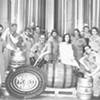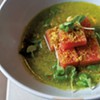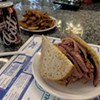Published October 18, 1995 at 4:00 a.m.
Sages and scientists have long pondered what separates man from the other animals — manual dexterity, reason, emotion. But here's another, simpler suggestion: We like to drink beer. In the grand scheme of things, it's our privileged status as beer drinkers — as much as higher consciousness — that puts us over the top. On a good night, the two might even be indistinguishable.
It's been this way, apparently, since the dawn of civilization. Anthropologists tell us that our species first settled into organized farming communities in Mesopotamia 13,000 years ago. Why? To grow grain for making beer — the drink of gods, priests, kings and Ralph Cramden. The world's most ancient recipe, in fact, is one for beer, chiseled into a Sumerian stone tablet some 5000 years ago. We humans come by our role as the planet's party animal quite naturally.
So how is it that something as central to civilized living as fresh, well-crafted beer teetered on the brink of extinction in America? The same way that real bread went the way of Wonder for awhile, and locally owned newspapers became McPapers: Corporate mega-breweries make the sort of bland product that no one likes but everyone buys because it's cheap. But fortunately, the days when all beer was a corn-based yellow liquid resembling pee are behind us.
During the past 15 years, the number of American breweries has jumped from 44 to more than 470. A good chunk of this growth has been in the "micro-brewery" market — the small local and regional breweries that tend to make a greater variety of beers and stand head and shoulders above most corporate brands and imports.
Four of the finest are right here in Vermont. Catamount cofounder Alan Davis speaks for them all: "Microbrewing is a philosophical movement as well as a business venture. We want to make a beer that is a quality, distinctive product that is not otherwise available to the consumer."
According to Roger Clapp, deputy commissioner for agricultural development, Vermont has the most breweries per capita of any state in the union. Brewing is now a big enough deal in the state's economy to be featured in promotional literature aimed at tourists. Long identified with maple, dairy and specialty foods, the word "Vermont" may soon also say great beer to the rest of the nation.
A related development is a small-scale, experimental hop farm — the largest east of Idaho — in Thetford, run by 43-year-old John Blumberg. His first harvest, brought in three weeks ago, will appear in several pubs throughout the state this year as Thetford Red Ale.
The only problem with the renaissance in beer is having to make sense of the bewildering array now crowding our stores and pubs (see glossary, page 10). Rather than sorting it out by myself, I took a taste tour through the beers of Vermont — and a few from Montréal and Maine — with Greg and Nancy Noonan, owners of Burlington's Vermont Pub and Brewery and the Seven Barrel Brewery in West Lebanon, N.H. Author of Brewing Lager Beers, Scotch Ales and the forthcoming Seven Barrel Book of Brewing, Greg Noonan is a renowned expert on the heady stuff. He'd just returned from the Great American Beer Festival in Boulder, where he was one of 68 judges from around the world — only two were from New England. His palate was especially keen.
Most of the beers we tasted are high quality, though the Vermont ones generally outclass those from Maine. McAuslan's, the single Montréal brewery, is making exceptional beers across the board. The Vermont beers had an advantage, of course, as freshness is everything. Ail the more disappointing, then, to find inconsistent quality in the lineup from Long Trail — once top-of-the-line in the state.
Both Catamount and Otter Creek are producing only first-rate beers — rivaling the best of their kind in the country. The new kid, Magic Hat, has a smaller selection but is also making beers of distinction.
Catamount is the grand old man of Vermont's breweries at eight years old. It has also carved out a clear niche in America's growing premium beer market. British beer guru Michael Jackson, author of Michael Jackson's Beer Companion and star-guide of the Beer Hunter video series, places Catamount Gold among the world's top 24 beers.
Catamount was cofounded in 1987 by Alan Davis in White River Junction for reasons both practical and aesthetic: proximity to interstate highways and the plentiful, mineral-rich artesian well water that accentuates the hoppiness of their British-style ales. Brewmaster — and triathlete — Steve Mason is currently producing 20,000 barrels. Plans are under way to build a new plant with a 50,000-barrel capacity. Catamount is currently the most widely distributed of Vermont's breweries. Its products are Amber, Gold, Pale Ale, Porter, American Wheat, Octoberfest, Christmas Ale and Bock.
The Burlington newcomer, Magic Hat Brewery, makes Vermont's grooviest beers. Ingenious packaging includes hip graphics and enigmatic comments on the underside of the crown caps — such as "Love is blind to your behind," and "Suck the toe of Edgar Allen Poe."
President Alan Newman, former president and cofounder of environmentally friendly Seventh Generation, teamed up with brewer Bob Johnson, a former assistant brewer at Otter Creek. The pair brewed their first batch of ale last November, and soon expanded the line to include an India Pale Ale called Blind Faith, and an oddity called #9. The latter is rather nondescript except for its heavy dose of apricot flavoring. Nonetheless, it's all the rage in Burlington. Currently Magic Hat's beer is bottled in Portland, Maine.
Newman views Magic Hat as a company with an upfront socially responsible ethic and products with a strong personality. He's the marketing whiz here, and leaves the brewing to Johnson. Among the many cool things about the company: "Growlers," the one-gallon glass jugs you can fill up with beer — for $6 — anytime you stop by the brewery off Flynn Avenue. Gotta love it.
After traveling in Europe and on the West Coast, brewer Andy Pherson founded the Long Trail line of beers in November 1989 in Bridgewater, where he'd kept a summer home for several years. From the start, demand has outstripped capacity, and the current 12,000-barrel facility will soon be expanded. Long Trail Ale is second only to Anheuser-Busch in draft sales in Vermont — no easy task. Actually Long Trail focuses almost exclusively on the Vermont market, shipping only small amounts to neighboring states.
Quality at Long Trail during the past year has not always matched that of its earlier successful years. While far from lost in the woods, it's getting tired out there on the Trail — probably due to dated equipment. With its expansion, the beers ought to be back on track. Product line: Long Trail Ale, India Pale Ale, Kolsch, Brown Ale, Stout, Brown Bag Ale, Harvest Ale.
Otter Creek is an exciting brewery making astoundingly rapid progress. Founder/brewmaster Lawrence Miller, 28, was recently named Vermont's Young Entrepreneur of the Year by the U.S. Small Business Administration. His 5-year-old plant is the third-fastest-growing in the country. Recent expansion into a state-of-the-art brewery will bring production levels up to a possible 40,000 barrels in coming years. This will allow Miller to meet increasing demand for his product throughout the Northeast.
Otter's line of beers is uniformly high quality. The flagship brew, Copper Ale, is exceptional. Helles Alt is also a compelling drink. Other brews include the hearty Stovepipe Porter, Hickory Switch Smoked Amber Ale and two seasonal beers, Summer Wheat Ale and Mud Bock Spring Ale.
Before sampling all the Vermont and regional beers — this could take quite awhile — first bone up on the vocabulary. And if you really want to sound erudite, try out two new terms that even Greg Noonan didn't know before the Boulder beer bash: "Session beer" — a not especially demanding brew to imbibe while hanging out with friends. And "headphone beer" — a complex beer to savor slowly and contemplate. Bottoms up.
Words to Drink By
Broadly speaking, there are two kinds of beers:
ALE, an older style and brewed at warmer temperatures using top fermenting yeasts. Generally more full-flavored and fruitier, ales make up the vast majority of microbrewed beer.
LAGER, made at cooler temperatures with yeasts that are bottom fermenting. Left to mature for some time in cold storage before being released, they are usually lighter, smoother and less complex than ales. Most national brands are lagers.
STYLES:
GOLDEN ALE, An American style of ale dating from the late 19th century. Lighter in color and less bitter than pale ales. Excellent examples include Catamount Gold and Otter Creek Helles Alt.
AMBER ALE, A richer style of golden ale, though still milder than pale ales. A very popular modern American style. Good example: Catamount Amber.
PALE ALE, Pale, that is, in comparison to brown and black ales. Pale ales are actually copper, bronze or amber-red in color. Generally fruity and full-flavored with a pleasantly bitter finish.
INDIA PALE ALE, Pale ale with an extra dose of hops, giving the beer a decidedly tangy and bitter flavor. Created by the queen's brewers as a means of preserving beer during the long voyage to India. Two good examples: Magic Hat's Blind Faith and the Old East India Pale Ale from Maine's Seadog Brewing.
BROWN ALE, Full-bodied and slightly sweet due to the heavy emphasis on malt and the sparing use of hops. Typically rich and creamy. An outstanding regional example: Griffon Brown Ale from McAuslan's.
IRISH ALE, Round, soft and buttery with understated bitter and fruit character. Magic Hat Ale is a terrific example.
ALTBIER, "Alt" here means old-style and is not indicative of age. A northern German style somewhat akin to a pale ale. A beautiful American interpretation is the Copper Ale from Otter Creek.
KOLSCH, Very light in body and clean tasting, this pale, soft, mildly fruity ale takes its name from the German city of Cologne. Even lighter than golden ales. The only example here — and a good one — is Long Trail's.
PORTER, Dark, heavy and very full-flavored. Deep and rich with roasted malt flavors like caramel, coffee or chocolate. Catamount Porter is a very good example, as is Otter Creek's Stovepipe Porter.
STOUT, A richer and somewhat acrid style of Porter. Some stouts are made with a percentage of oatmeal along with the barley. A truly amazing example of this intensely flavored, creamy and chocolately style of stout is the St. Ambroise Oatmeal Stout from McAuslan's.
OCTOBERFEST, A copper-colored lager with a pronounced sweet and spicy, malty flavor. Originally an Austrian and German style of beer made to celebrate the autumn harvest. Catamount makes an exceptional one.
HARVEST ALE, The ale version of an Octoberfest.
SEASONAL BEERS, Limited-edition brews released at different times of the year: dark, malty bock (an extra-rich lager) beers in spring, light and tangy wheat beers in summer, and spicy, full-flavored winter warmers during the holiday season.
SMOKED BEERS, Beers made from barley malt that has been roasted over a wood fire. Otter Creek's Hickory Switch Smoked Amber Ale is a very good example.
More By This Author
Speaking of...
-

Waterbury’s Craft Beer Cellar Gets a New Name — and a Bar
Feb 27, 2024 -

Video Guide: Things to Do in Vermont During the Eclipse
Jan 25, 2024 -

Winooski’s Vermont Homebrew Supply to Close
Jan 16, 2024 -

Morrisville’s Lost Nation Brewing Charts a Path Through a Changing Beer Landscape
Jan 9, 2024 -

Hey Bub, Citizen Cider's New Light Beer, Brews Trouble With Staff
Sep 25, 2023 - More »
Comments
Comments are closed.
From 2014-2020, Seven Days allowed readers to comment on all stories posted on our website. While we've appreciated the suggestions and insights, right now Seven Days is prioritizing our core mission — producing high-quality, responsible local journalism — over moderating online debates between readers.
To criticize, correct or praise our reporting, please send us a letter to the editor or send us a tip. We’ll check it out and report the results.
Online comments may return when we have better tech tools for managing them. Thanks for reading.










































